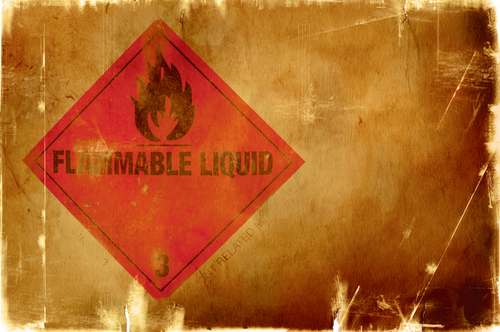OSHA’s flammable liquids standard (29 CFR 1910.106) explains what these substances are and how to store and use them safely
 |
Since the primary hazards associated with flammable liquids are explosion and fire, the standard emphasizes construction and location of storage areas for flammable liquids to prevent buildup of hazardous vapors as well as procedures to control and extinguish any fires that do start. The regulation also includes steps to follow to prevent contact between flammable liquids and ignition sources.
The flammable liquids rule applies to any employers that handle, store, or use flammable liquids with a flash point at or below 199.4 degrees Fahrenheit (93 degrees Celsius).
In addition to 1910.106, these OSHA standards contain provisions directly related to the flammable liquid rule for general industry:
- 29 CFR 1910.1200—Hazard Communication Standard, or worker right to know
- 29 CFR 1910.107—Spray finishing using flammable and combustible materials
- 29 CFR 1910.108—Dip tanks
- 29 CFR 1910.125—Additional requirements for dipping and coating operations
Department of Transportation regulations (49 CFR Parts 171 to 173) governing the general requirements for flammable liquid shipments and packaging may also apply.
Flammable liquids are found in most industrial workplaces and pose significant risks. BLR’s upcoming live webinar will help you manage flammable liquids safely and meet the requirements of OSHA’s flammable liquids standard. Click here for details.
Key Issues for Industrial Plants
When flammable liquids are stored and used in industrial plants, the following rules apply:
- Incidental storage or use of flammable liquids. All storage must be in tanks or closed containers. The quantity of liquids allowed in manufacturing/production areas (outside of primary storage) is limited according to the liquid category and whether a container or a tank is utilized for storage. Transfer of liquids must be separated from other operations by an adequate distance or fire-resistant construction. A closed piping system, safety cans, or a gravity system may be used for transfer. Air pressure transfer is prohibited. Adequate ventilation must be maintained. Means of spill or leakage prevention, control, cleanup, and disposal must be provided. Any possible source of ignition must be eliminated when using Category 1 liquids.
- Unit-physical operations. Physical operations are restricted to operations not involving chemical change. All buildings and equipment must be accessible for fire-fighting purposes. Unstable liquids and small-scale chemical processes must be isolated by a 2-hour (minimum) firewall. Emergency drainage systems must direct flammable liquids to a safe location. Appropriate ventilation must be maintained when using Category 1 liquids so as to provide adequate air exchange, discharge to a safe location, and proper ventilation of floor areas or pits. Equipment must be of appropriate design for use with Category 1 liquids so as to limit flammable vapor-air mixtures.
- Tank vehicle and tank car loading and unloading. The distance of separation from aboveground tanks, warehouses, other plant buildings, or nearest adjoining property lines is based on liquid category.
- Fire control. Fire control equipment, water supply, and any special extinguishing equipment must be adequately maintained and periodically inspected and be appropriate in quantity and type for the potential hazards. Local fire marshals must be consulted to determine specific requirements.
Join us on April 29 for an in-depth webinar on the flammable liquids standard. You’ll find out how to prevent explosions and fire hazards for nonbulk flammables and stay in compliance with OSHA requirements. Learn More.
- Sources of ignition. Possible sources of ignition must be carefully identified and controlled. Dispensing of Category 1 liquids must be done with proper grounding.
- Electrical. Locations (including surrounding areas) where flammable vapor-air mixtures may exist under normal conditions must meet Class I, Division 1 standards. Locations (including surrounding areas) where flammable vapor-air mixtures may exist under abnormal conditions must meet Division 2 standards. If only Category 3 and 4 liquids are used, ordinary electrical equipment is permitted.
- Repair to equipment. Repairs must be supervised by a knowledgeable and responsible individual whenever hot work is required.
- Housekeeping. Housekeeping must be adequate to control leaks and prevent spills. Aisle space must be adequate for fire response access. Combustible wastes and residues must be minimized, stored properly, and disposed of daily. Ground area around buildings and unit operating areas must be kept free of weeds, trash, or other unnecessary combustible materials.
- Maintenance and repair. Maintenance and repair, including hot work, are permitted only under the supervision of a responsible individual in charge. This individual must make an inspection of the area before and after work.
